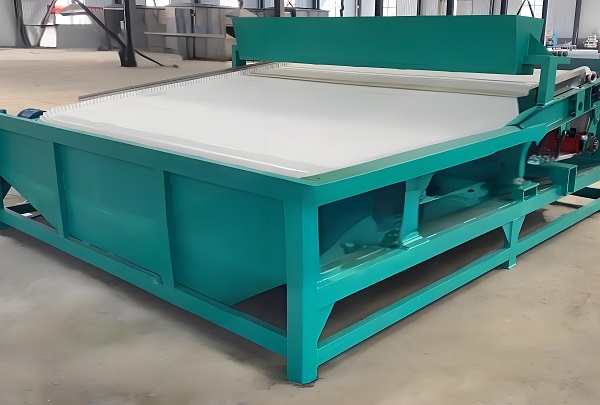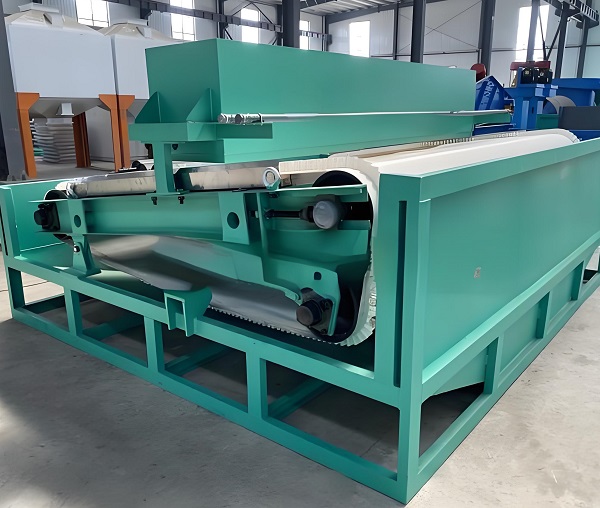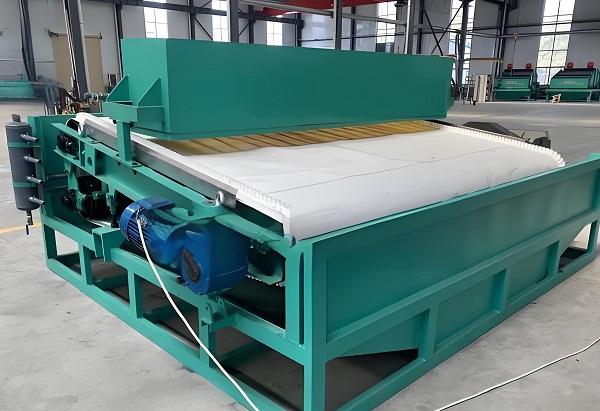PS: As a key equipment in the mineral processing industry, the stable operation of magnetic separator is crucial to production. However, various faults are inevitable during long-term use. Mastering the knowledge and skills of magnetic separator fault maintenance can solve problems in a timely and effective manner, reduce downtime, and ensure the continuity and efficiency of production.
A. Common fault types and causes of magnetic separators

Magnetic Separator
1. Mechanical failure
Bearing overheating: It may be insufficient lubrication, poor quality of lubricating oil or impurities, which leads to increased bearing friction and excessive heat. In addition, improper bearing installation, such as overtightening or eccentricity, can also cause bearing overheating.
Belt slippage: Insufficient belt tension is a common cause. As the use time increases, the belt will stretch to a certain extent, resulting in a decrease in tension. At the same time, oil stains or severe wear on the belt surface will also reduce the friction between the belt and the drive wheel, causing slippage.
Cylinder wear: During the operation of the magnetic separator, the cylinder will frequently contact and rub with the slurry and magnetic materials. If the slurry concentration is too high, the flow rate is too fast, or the magnetic material contains particles with higher hardness, it will accelerate the wear of the cylinder.
2. Electrical failure
The motor does not start: Power failure, such as phase loss, low or high voltage, will cause the motor to fail to start normally. Short circuit, open circuit or grounding of the motor winding will also cause the motor to lose its normal operating ability. In addition, damage to components such as contactors and relays in the control circuit, or poor line contact, may also cause the motor to fail to start.
Motor overheating: Excessive load, such as long-term overload operation of the magnetic separator, will increase the motor current and generate too much heat. Poor motor heat dissipation, such as damage to the cooling fan and blocked vents, will also cause the motor temperature to be too high. In addition, the insulation performance of the motor is reduced, which will cause leakage and lead to motor overheating.
3. Magnetic separation performance failure
Low recovery rate of magnetic products: Insufficient magnetic field strength of the magnetic separator is an important reason, which may be due to aging of the magnetic system, demagnetization of the magnetic block or damage to the magnetic system structure. Excessive feed, exceeding the processing capacity of the magnetic separator, will prevent the magnetic particles from being fully adsorbed in time. Too high or too low slurry concentration will affect the dispersion and movement of magnetic particles in the slurry and reduce the recovery rate.
Low concentrate grade: It may be due to magnetic inclusions, that is, non-magnetic minerals are entrained into the concentrate by magnetic minerals. This may be because the magnetic field selectivity is poor during the magnetic separation process, and it is impossible to effectively distinguish magnetic and non-magnetic minerals. At the same time, the unreasonable working gap of the magnetic separator will lead to incomplete separation of magnetic and non-magnetic minerals, affecting the concentrate grade.
B. Magnetic separator fault repair skills

Magnetic Separator
1. Mechanical fault repair
Bearing overheating treatment: First check the amount and quality of the lubricating oil, and replenish or replace the lubricating oil in time. If it is an installation problem, it is necessary to readjust the installation position of the bearing to ensure the installation accuracy. When removing and installing the bearing, special tools should be used to avoid damage to the bearing.
Belt slip repair: Adjust the tension of the belt by adjusting the tensioning device. If there is oil on the surface of the belt, wipe it clean with a clean cloth. For severely worn belts, new belts should be replaced in time. At the same time, the tension of the belt should be checked regularly to ensure that it is always in a suitable state.
Cylinder wear repair: For slightly worn cylinders, repair welding can be used. First, clean and polish the worn parts, and then use a suitable welding rod for repair welding. After repair welding, the weld should be polished to make the surface smooth to avoid affecting the normal rotation of the cylinder. For severely worn cylinders, a new cylinder needs to be replaced.
2. Electrical fault repair
Motor does not start troubleshooting: Check the power supply line, use a multimeter to measure the power supply voltage, and determine whether there are problems such as phase loss and voltage abnormality. If the power supply is normal, check the resistance value of the motor winding to determine whether there is a short circuit, open circuit or grounding. For the control circuit, check the working status of components such as contactors and relays one by one, and repair or replace damaged components.
Solution to motor overheating: If the load is too large, it is necessary to adjust the working parameters of the magnetic separator to reduce the load. Check the heat dissipation system of the motor, clean the debris in the vents, and repair or replace the damaged cooling fan. For motors with reduced insulation performance, the windings should be insulated, such as re-painting, wrapping insulation materials, etc.
3. Repair of magnetic separation performance failure
Improve the recovery rate of magnetic products: Check the magnetic system, replace the demagnetized magnetic blocks in time, and repair the damaged magnetic system structure to improve the magnetic field strength. Reasonably control the feed rate and adjust it according to the processing capacity of the magnetic separator. Optimize the slurry concentration and determine the optimal slurry concentration range through experiments.
Improve the concentrate grade: Adjust the magnetic field characteristics of the magnetic separator, such as changing the magnetic field strength, magnetic field gradient, etc., to improve the selectivity of the magnetic field. Optimize the working gap of the magnetic separator, find the best gap value through experiments, and ensure that magnetic minerals and non-magnetic minerals can be effectively separated. At the same time, pre-treat the selected materials to remove impurities that may cause magnetic inclusions.
C. Debugging and maintenance of magnetic separator after repair

Magnetic Separator
1. Debugging: After completing the fault repair, the magnetic separator should be fully debugged. First, conduct a no-load test run to check whether the mechanical operation of the equipment is normal and whether there is any abnormal noise and vibration. Then conduct a load test run, gradually increase the feed rate, and observe whether the magnetic separation performance of the magnetic separator, such as the recovery rate of magnetic products and the concentrate grade, meets the requirements. During the debugging process, the equipment parameters should be adjusted according to the actual situation.
2. Maintenance: Establish a regular maintenance system to regularly inspect, clean, lubricate and other maintenance work on the magnetic separator. Strengthen the monitoring of the equipment's operating status, such as installing sensors to monitor motor current, temperature, cylinder vibration and other parameters, and promptly discover potential fault hazards. At the same time, it is necessary to keep good maintenance records of the equipment, including fault phenomena, maintenance methods, maintenance time, etc., to provide reference for subsequent equipment maintenance and management.
PS: Mastering the knowledge and skills of magnetic separator fault maintenance can help us quickly and accurately solve various problems that arise during the operation of the equipment. In actual work, we must constantly sum up experience and improve fault diagnosis and maintenance capabilities. At the same time, strengthen the daily maintenance and management of equipment, prevent the occurrence of faults, ensure that the magnetic separator is always in good operating condition, and provide strong guarantees for production.
Save Time! Get A Detailed Quotation Quickly.
